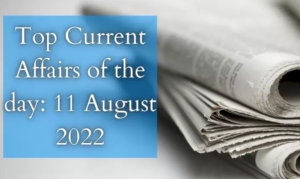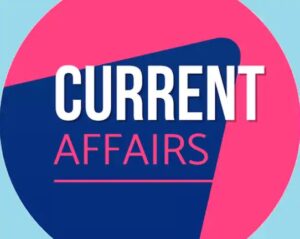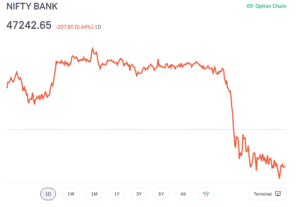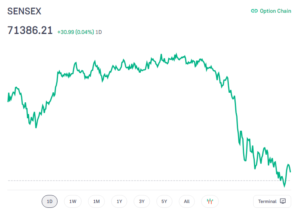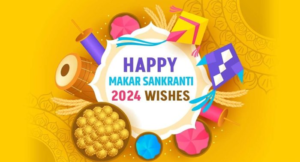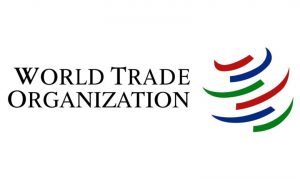
India beats Indonesia 16-0 in Asia Cup 2022 hockey tournament
Indian men’s team slammed six goals in the final quarter to record a 16-0 win over Indonesia in a thrilling Pool A game of the Asia Cup 2022 to qualify for the Super 4 stage of the Asia Cup. India joined Japan, Malaysia, and South Korea in the Super 4 round of the Asia Cup. India needed to win the contest by at least a 15-0 margin to qualify and the young side thrived under pressure.
Both India and Pakistan finished on four points each in Pool A behind Japan but the holders qualified for the Super 4s on the basis of a better goal difference (1). Pakistan had lost 2-3 to Japan earlier in the day. This was India’s first win in the ongoing edition of the Asia Cup as they were held to a 1-1 draw by Pakistan before suffering a 2-5 defeat at the hands of Japan, who finished first in Pool A. Japan won all of their three matches in the pool.
26-year-old Abhilasha Barak becomes the Indian Army’s first woman combat aviator
Abhilasha Barak
Haryana’s Captain Abhilasha Barak has become the first woman officer to join the Army Aviation Corps as a combat aviator after successfully completing her training. She was awarded the coveted wings along with 36 other army pilots by the DG and Colonel Commandant of Army Aviation in Nashik. She has been assigned to the second flight of the 2072 Army Aviation Squadron. She was commissioned into the Indian Army from the Officers Training Academy, Chennai in 2018.
Career of Captain Abhilasha Barak:
- Captain Barak is an alumnus of The Lawrence School, Sanawar. She completed her graduation with B-Tech in Electronics and Communication Engineering from Delhi Technological University in 2016 and was placed at Deloitte, USA.
- During her attachment with the Corps of Army Air Defence, she was selected as a Contingent Commander for Presentation of Colours to Army Air Defence by President Ram Nath Kovind.
- She attained an ‘A’ grading in the Army Air Defence Young officers course, 75.70 per cent in Air Traffic Management and Air Laws course and passed the promotional exam, Part B, in her first attempt.
IBA Women’s World Boxing Championships: Turkey topped medal tally of 2022
The 12th edition of the 2022 International Boxing Association (IBA) Women’s World Boxing Championship (WWBC) was held at Başakşehir Youth and Sports Facility, Istanbul, Turkey. The event saw the participation of 310 Boxers from 73 nations. Belarusian and Russian boxers were not allowed to compete at the event after a ban as a result of the Russian invasion of Ukraine.
Key points:
- India for the first time in the past four years, had won a total medal tally of 3, which includes one Gold and two Bronze.
- The India Boxer Nikhat Zareen( from Nizamabad, Telangana) won the gold in the flyweight (52kg) division with 5-0 points against Thailand’s Jitpong Jutamas. With this win, she became the fifth Indian women boxer to win the World Championship.
- The other two Indian women boxers Manisha Moun (from Haryana) and Parveen Hooda(from Haryana) had won the bronze medals in the 57kg and 63kg categories respectively.
Overall Medal Tally:
| Rank | Nation | Gold | Silver | Bronze | Total |
| 1 | Turkey | 5 | 0 | 2 | 7 |
| 2 | Ireland | 2 | 0 | 0 | 2 |
| 3 | Canada | 1 | 1 | 0 | 2 |
| 4 | India | 1 | 0 | 2 | 3 |
Prime Minister Modi chaired the 40th PRAGATI Interaction
The Prime Minister, Shri Narendra Modi has urged infrastructure agencies to map their projects with the water bodies being constructed under the Amrit Sarovar. Mr Modi stated that this would be a win-win situation because the material needed for the Amrit Sarovars could be used by the agencies for public works. The Prime Minister presided over the 40th edition of PRAGATI, an ICT-based multi-modal platform for Pro-Active Governance and Timely Implementation that brings together the Centre and State governments.
KEY POINTS:
- Nine agenda items, comprising eight projects and one programme, were reviewed during the meeting.
- The total cost of these eight projects in the 14 states is around 59 thousand 900 million rupees.
- Jharkhand, Maharashtra, Karnataka, Andhra Pradesh, Tamil Nadu, Chhattisgarh, Odisha, Assam, Arunachal Pradesh, Meghalaya, Tripura, Mizoram, Nagaland, and Sikkim are among the states involved.
- Prime Minister Modi also discussed the ‘National Broadband Mission’ programme at the meeting. States and agencies were asked to use the centralised Gati Shakti Sanchar Portal to ensure that Right of Way (RoW) applications were processed quickly.
States may also construct state-level GatiShakti Master Plans based on the PM GatiShakti National Master Plan and establish state-level entities for this purpose, according to the Prime Minister.
APJ ABDUL KALAM: THE MISSILE MAN OF INDIA
“Failure will never overtake me if my determination to succeed is strong enough.”
-APJ Abdul Kalam
APJ Abdul Kalam, full name – Dr. Avul Pakir Jainulabdeen Abdul Kalam – The Missile Man of India, (born October 15, 1931, Rameswaram, India—died July 27, 2015, Shillong). APJ Abdul Kalam was a great Indian scientist who worked miraculously for India’s missile Technology and nuclear weapons programs and politician who played a leading role in the development of India. He served as a president of India from 2002 to 2007.
Life of APJ Abdul Kalam:
After graduating from Madras Institute of Technology with a degree in aeronautical engineering, Kalam joined the Defence Research and Development Organisation (DRDO) in 1958. He joined the Indian Space Research Organisation in 1969 as project director of the SLV-III, the country’s first satellite launch vehicle. When he returned to the DRDO in 1982, he oversaw a programme that resulted in a number of successful missiles, earning him the moniker Missile Man.
From 1992 to 1997, Kalam was the defence minister’s scientific adviser, and from 1999 to 2001, he was the government’s principal scientific adviser with the title of cabinet minister. Although the tests raised worldwide alarm, Kalam’s important role in the country’s 1998 nuclear weapons testing cemented India’s status as a nuclear power and elevated him as a national hero. In 1998, Kalam proposed Technology Vision 2020, a statewide strategy that he described as a road map for converting India from a developing to a developed society in 20 years. Increasing agricultural productivity, prioritising technology as an engine for economic growth, and expanding access to health care and education were among the goals outlined in the plan.
Kalam was nominated by India’s ruling National Democratic Alliance (NDA) to succeed outgoing President Kocheril Raman Narayanan in 2002. Despite being Muslim, Kalam was nominated by the Hindu nationalist (Hindutva) NDA, and his status and popularity were such that the Indian National Congress, the main opposition party, also proposed his candidacy. Kalam easily won the election, and in July 2002, he was sworn in as India’s 11th president, a purely ceremonial position. He was succeeded by Pratibha Patil, the country’s first female president, when his term expired in 2007.
Post President Life of APJ:
Following his return to civilian life, Kalam remained committed to utilising science and technology to help India become a developed country, lecturing at a number of universities. He fell while delivering a lecture at the Indian Institute of Management Shillong on July 27, 2015, and was pronounced dead shortly after from cardiac arrest. Kalam wrote several books, including Wings of Fire, an autobiography (1999). Two of the country’s highest honours, the Padma Vibhushan (1990) and the Bharat Ratna (2001), were among his many accolades (1997).
Famous Quotes by APJ:
- Look at the sky. We are not alone. The whole universe is friendly to us and conspires only to give the best to those who dream and work.
- We should not give up and we should not allow the problem to defeat us.
- If four things are followed – having a great aim, acquiring knowledge, hard work, and perseverance – then anything can be achieved.
- Teaching is a very noble profession that shapes the character, caliber, and future of an individual. If the people remember me as a good teacher, that will be the biggest honour for me.
- Where there is righteousness in the heart, there is beauty in the character. When there is beauty in the character, there is harmony in the home. When there is harmony in the home, there is order in the nation. When there is order in the nation, there is peace in the world.
- Unless India stands up to the world, no one will respect us. In this world, fear has no place. Only strength respects strength.
- The purpose of education is to make good human beings with skill and expertise… Enlightened human beings can be created by teachers.
- Let me define a leader. He must have vision and passion and not be afraid of any problem. Instead, he should know how to defeat it. Most importantly, he must work with integrity.
-
Climbing to the top demands strength, whether it is to the top of Mount Everest or to the top of your career.
-
My message, especially to young people is to have courage to think differently, courage to invent, to travel the unexplored path, courage to discover the impossible and to conquer the problems and succeed. These are great qualities that they must work towards. This is my message to the young people.
FAQs
Ques. Why APJ Abdul Kalam is famous?
Ans. Avul Pakir Jainulabdeen is Abdul Kalam’s full name. Abdul Kalam was an Indian scientist and politician who played a key role in the creation of India’s missile and nuclear weapons programmes. He was born on October 15, 1931, in Rameswaram, India, and died on July 27, 2015, in Shillong. From 2002 until 2007, he served as India’s president.
Ques. Who is APJ Abdul Kalam wife?
Ans. APJ Abdul Kalam was unmarried throughout his life. Jainulabiddin Marakayar (Imam) and Ashiamma Jainulabiddin Jainulabiddin Jainulabiddin Jainulabiddin Jainulabiddin Jainulabiddin Jainulabiddin Jainulabiddin Jain (Housewife). Kasim Mohammed, Mohammed Muthu Meera Lebbai Maraikayar, and Mustafa Kamal were his three brothers, while Asim Zohra was his oldest sister. He remained single for the whole of his life.
Ques. Why is Dr APJ Abdul Kalam called missile Man?
Ans. As a result of his contributions to the development of ballistic missile and launch vehicle technology, he became known as India’s Missile Man. In 1998, he also had a key organisational, technical, and political role in India’s Pokhran-II nuclear testing, the first since the country’s first nuclear test in 1974.
Ques. Who is the missile Man of India?
Ans. Dr. APJ Abdul Kalam is known as the Missile man of India due to his contributions to the development of ballistic missile and launch vehicle technology. When he returned to the DRDO in 1982, he oversaw a programme that resulted in a number of successful missiles, earning him the moniker Missile Man.
Ques. Did Abdul Kalam ever receive a Nobel Prize?
Ans. Abdul Kalam is not awarded the Nobel Peace Prize. However, he has received numerous prizes, including the Bharat Ratna and numerous more.
Fintech startup Mahagram partners with IndusInd Bank to nurture digital payments
Rural NEO Bank Mahagram has tied up with the IndusInd Bank to digitize the nation’s payment ecosystem and provide a wider scope to transact for its customers in rural India. Mahagram was launched with a vision to transform India into a digitally empowered society and knowledge economy. The partnership between the two aims to boost financial inclusion, encourage socio-economic development, mitigate the risks of a shadow economy, and accelerate the growth of a cashless society.
This association will also ensure the building of an efficient, reliable, and secure payment ecosystem, which will not only promote and encourage the use of e-payments methods but will also help merchants across the country to accept digital payments easily, making it more accessible for everyone.
Important takeaways for all competitive exams:
- IndusInd Bank Founded: 1994;
- IndusInd Bank Headquarters: Mumbai, Maharashtra;
- IndusInd Bank MD & CEO: Sumant Kathpalia;
- IndusInd Bank Tagline: We Make You Feel Richer.
RBI issued guidelines for certified jewellers’ Gold import
The Reserve Bank of India (RBI) has announced new guidelines to permit qualified jewellers to import gold through the India International Bullion Exchange IFSC Ltd. (IIBX) or any other exchange. IFSCA and the DGFT, the Government of India, must sanction the other exchanges. All payments by authorised jewellers for gold imports through IIBX must be done using an exchange mechanism recognised by IFSCA in accordance with the IFSC Act and regulations, according to the RBI.
KEY POINTS:
- According to the new recommendations, approved dealers banks may allow Qualified Jewellers to make eleven-day advance payments for gold imports through IIBX in accordance with the existing Foreign Trade Policy and Regulations published under the IFSC Act.
- In accordance with the terms of the sale contract or other document in the nature of an irrevocable purchase order in terms of the IFSC Act and regulations made thereunder by IFSCA, AD banks shall ensure that advance remittance for such import through exchange/s authorised by IFSCA is in accordance with the terms of the sale contract or other document in the nature of an irrevocable purchase order in terms of the IFSC Act and regulations made thereunder by IFSCA.
- Furthermore, licenced dealers banks must perform all due diligence and guarantee that the remittances sent are only for bona fide import transactions through IFSCA-approved exchanges.
- The RBI further noted that advance remittances for gold imports should not be used in any way to import gold worth more than the advance remittance made.
- QJ shall send the Bill of Entry (or any other applicable document issued/approved by Customs Department for evidence of import) issued by Customs Authorities to the AD bank from which advance payment has been made if gold is imported through IIBX.
Moody’s cuts India’s economic growth forecast to 8.8% for 2022
Moody’s Investors Service slashed India’s economic growth projection to 8.8 per cent for 2022 from 9.1 per cent earlier, citing high inflation. In its update to Global Macro Outlook 2022-23, Moody’s said high-frequency data suggest that the growth momentum from December quarter 2021 carried through into the first four months this year. However, the rise in crude oil, food and fertilizer prices will weigh on household finances and spending in the months ahead. Rate hikes to prevent energy and food inflation from becoming more generalized will slow the demand recovery’s momentum.
Strong credit growth, a large increase in investment intentions announced by the corporate sector, and a high budget allocation to capital spending by the government indicate that the investment cycle is strengthening. For 2022 and 2023, it projected inflation to be around 6.8 per cent and 5.2 per cent, respectively.
UNICEF-WHO release the first Global Report on Assistive Technology
The World Health Organization (WHO) and the United Nations Children’s Fund (UNICEF) have released the first Global Report on Assistive Technology (GReAT). The paper, which was created in conjunction with UNICEF’s Office of Research – Innocenti, includes 10 important actionable suggestions for enhancing access to assistive technology for all children, as well as evidence-based best practise examples.
KEY POINTS:
- Through a network of academic institutions, researchers, policymakers, donors, and practitioners, UNICEF Office of Research – Innocenti is at the forefront of the establishment of a Global Research Agenda and Platform for Children to amplify the voice of children and youth with disabilities.
- With the help of UNICEF‘s Office of Research – Innocenti, UNICEF and WHO created a series of 11 free-access background papers to accompany the Report.
- Around the world, 2.5 billion people require assistive technology. According to the estimate, by 2050, the population will have grown to 3.5 billion people.
- The gaps between low- and middle-income countries and high-income countries in terms of access to assistive technology are disturbing.
- Access to assistive technology for individuals who need it is as low as 3% in some low- and middle-income nations, whereas it is significantly higher in high-income countries, with up to 90% of people receiving the assistive devices and services they require.
- The worldwide impact of the WHO-UNICEF Global Report on Assistive Technology in this scenario will be unprecedented. Enabling settings and Assistive Technology are recognised in the Global Report as prerequisites for people in need to realise their human rights.
Important Takeaways For All Competitive Exams:
- World Health Organization (WHO) headquarters: Geneva, Switzerland
- United Nations Children’s Fund (UNICEF) headquarters: New York, United States
Postal Department and India Post payments Bank (IPPB) Aarohan 4.0 begins in Shimla
Two days meeting of senior functionaries of the Postal Department and India Post payments Bank (IPPB), AAROHAN 4.0 started in Shimla, Himachal Pradesh. The agenda of the meeting is to discuss and deliberate ways to further deepen the Financial Inclusion drive in the country and to provide banking solutions to every citizen of India. Postal Department along with IPPB is working on the vision of the Prime Minister’s Digital India initiative to promote digital payments and bring digital banking services to every nook and corner of the country in a customer-friendly manner.
IPPB leverages upon the world’s largest postal network of the Department of Posts to offer interoperable banking services at the doorstep benefiting senior citizens, farmers, migrant labourers and women amongst others. The meeting was inaugurated by Shri. Alok Sharma, Director General Postal Services in presence of Shri J Venkatramu, MD & CEO of IPPB, Chief PMG of 23 Postal Circles and other senior functionaries of the Department and IPPB. Discussions were held today to further strengthen the synergy between the post office and IPPB operations.
About India Post Payments Bank India Post Payments Bank (IPPB):
The bank has been established under the Department of Posts, Ministry of Communication with 100% equity owned by the Government of India. IPPB was launched by the Hon’ble Prime Minister Shri Narendra Modi on September 1, 2018. The bank has been set up with the vision to build the most accessible, affordable and trusted bank for the common man in India.
India to introduce made in India TB infection skin test called “c-TB”
India will introduce a newly approved “made in India” TB infection skin test called ‘c-TB’, said Health Minister Mansukh Mandaviya. This cost-effective tool will be of immense benefit to other high burden countries as well. A new initiative, “Adopt people with TB” will be launched this year, based on Indian values of collectivism, which will call upon corporates, industries, organisations, political parties and individuals to come forward and adopt TB-infected people and families and provide them with nutritional and social support.
Among these are the ‘bidirectional testing’ of TB with Covid, house-to-house TB detection campaigns, scaling up of rapid molecular diagnostics at sub-district levels, use of artificial intelligence and digital tools, ‘Jan Andolan’, and most importantly, the decentralisation of TB services to Ayushman Bharat Health and Wellness Centres as part of comprehensive primary healthcare.
Meeting of the BRICS Foreign Affairs’ Ministers
Wang Yi, State Councilor and Foreign Minister, presided over a virtual meeting of BRICS Foreign Affairs/International Relations Ministers in Beijing. The conference was attended by Naledi Pandor, the South African Minister of International Relations and Cooperation, Carlos Alberto Franco França, the Brazilian Foreign Minister, Sergey Lavrov, and Subrahmanyam Jaishankar, the Indian External Affairs Minister.
KEY POINTS:
- At the meeting’s opening session, President Xi Jinping gave a video speech. President Xi Jinping spoke highly of the importance of the BRICS Foreign Ministers’ Meeting, elaborated on security and development, and expressed important views on deepening BRICS political and security cooperation, according to Wang Yi, pointing out the direction for us to make this meeting a success.
- The BRICS Foreign Ministers’ Meeting, according to Wang Yi, is a crucial platform for BRICS political and security cooperation.
- They issued a common message on significant international issues of shared concern on multilateral platforms during the last five years, under the strategic guidance of BRICS leaders, and we have resolutely preserved the five nations’ common interests.
- Due to enormous changes in the world and the COVID-19 pandemic, both of which have not been witnessed in a century, a range of new features and difficulties have evolved in the international scene.
- People need to know where we’re going, what the overall trend is, how to develop consensus, how to strengthen confidence, and how to understand and adapt to change.
- The foreign ministers in attendance commended President Xi Jinping for giving an important address at the Foreign Ministers’ Meeting, stating that it perfectly reflected China’s high regard for BRICS cooperation.
- All parties praised China’s active and effective work as the rotating chair, and expressed a desire to maintain close communication and collaboration with China, as well as make active efforts to ensure a successful BRICS Summit hosted by China.
- The foreign ministers praised China’s proactive role in combating the pandemic and addressing global climate change, and expressed their willingness to expand cooperation in pandemic response, trade, health, people-to-people and cultural affairs, climate change, and other areas, as well as fully implement the UN 2030 Agenda for Sustainable Development, to benefit people in developing countries and promote the creation of a global community with a shared future for humanity.
- Foreign ministers expressed support for the BRICS expansion process, stating that further conversations will take place on the subject.
- The foreign ministers also discussed Ukraine, Afghanistan, and other major concerns in the region.
- The summit resulted in the release of the BRICS Joint Statement on Strengthening BRICS Solidarity and Cooperation, Responding to New Features and Challenges in the International Situation.
- They should continue to show openness and inclusion, as well as lead by example in terms of unity and strength.
- It is critical to make effective use of the BRICS Plus model, to explore BRICS Plus collaboration at more levels, in more areas, and with a broader scope, to build solidarity and cooperation with emerging markets and developing nations, and to contribute more to global peace and development.
Important Points of President Xi Jinping Address
First Point:
- To begin, look for the lowest common denominator of universal security. President Xi Jinping recently announced the Global Security Initiative, which outlines a strategy for bridging the peace gap and resolving the global security crisis.
- Any attempt to achieve absolute security or exclusive security in today’s globe would fail due to the interdependence of countries.
- They must move beyond the I-win-you-lose Cold War attitude, respect and ensure each country’s security, and replace confrontation, coercion, alliance, and zero-sum thinking with conversation, collaboration, partnership, and win-win outcomes.
- They should act in accordance with true multilateralism, opposing unilateral sanctions and “long-arm jurisdiction.” It is critical to put the notion of indivisible security into practise and to encourage the development of a balanced, effective, and long-term regional security architecture.
- The BRICS countries should maintain their independence, objectivity, and impartiality, speak up for peace, do their best for peace, and assist Russia and Ukraine in their efforts to reach a peaceful resolution through communication and negotiation.
Second Point:
- For common development, try to draw concentric circles. President Xi Jinping has proposed the Global Development Initiative (GDI), which offers a Chinese response to global development issues.
- More than 100 countries and several international organisations, including the United Nations, have expressed supportive support for the GDI, and more than 50 countries have joined the GDI’s Group of Friends. Every country has an equal right to development.
- It’s critical to prioritise the 2030 Agenda’s implementation in the international cooperation agenda, and to pay close attention to poor nations’ actual challenges.
- Developed countries should take seriously their pledges and provide more finance, technology, and capacity-building assistance to poor countries.
Third Point:
- Work to create a human health firewall. The international pandemic response is at a vital juncture, and we must not squander it by giving up midway.
- They must work together to provide support, better coordinate response measures, and strengthen global health governance.
- China follows the dynamic zero-COVID policy, which aims to halt the pandemic’s spread as quickly as possible at the lowest possible cost, preserve people’s lives and health to the greatest extent possible, and minimise the pandemic’s impact on economic and social growth.
- The policy reflects a sense of duty toward the Chinese people as well as the rest of the globe.
Fourth Point:
- Make an effort to pool good global governance energy. Global challenges are surfacing one after the other right now.
- We can only deal with them appropriately by mobilising global resources and coordinating global efforts.
- Small circles can’t address the great issues that the entire globe is facing, and small groupings can’t adapt to today’s important changes.
- They must firmly defend the international system, which is centred on the United Nations and is anchored by international law, and ensure that everyone is involved in international affairs, international laws are set by everyone, and development outcomes are shared by everyone.
FAQs
RBI reduces net-worth requirement for non-bank Bharat Bill Payment units
The Reserve Bank of India (RBI) has eased norms for non-bank entities to set up Bharat Bill Payment operating units by reducing the net-worth requirement to Rs 25 crore, with a view to encouraging more players in the segment. At present, a net worth of Rs 100 crore is required to obtain authorisation for a non-bank BBPOU (Bharat Bill Payment Operating Units). The reduction in net-worth requirements follows an announcement regarding the same by the central bank in April.
To increase participation, the RBI had decided to align the net worth requirement of non-bank BBPOUs with that of other nonbank participants who handle customer funds (like payment aggregators) and have a similar risk profile.
About the Bharat Bill Payment System (BBPS):
Bharat Bill Payment System (BBPS) is an interoperable platform for bill payments and the scope and coverage of BBPS extend to all categories of billers who raise recurring bills. Users of BBPS enjoy benefits like a standardised bill payment experience, a centralised customer grievance redressal mechanism and a prescribed customer convenience fee.
Bharat Drone Mahotsav 2022: PM Modi inaugurated India’s biggest drone festival
Bharat Drone Mahotsav 2022
Prime Minister Narendra Modi has inaugurated India’s biggest drone festival here and interacted with Kisan drone pilots as well as witnessed open-air drone demonstrations. ‘Bharat Drone Mahotsav 2022’ is set to be a two-day event being held on May 27 and 28. The prime minister will interact with Kisan drone pilots, witness open-air drone demonstrations and interact with startups in the drone exhibition centre.
About the Bharat Drone Mahotsav 2022:
- According to the Prime Minister’s Office, more than 1600 delegates, consisting of government officials, armed forces, central armed police forces, Public Sector Units (PSUs), foreign diplomats, private companies as well as drone startups, etc., will participate in the Bharat Drone Mahotsav 2022.
- The PMO mentioned that more than 70 exhibitors will display various use cases of drones at the Drone Festival. The Bharat Drone Mahotsav 2022 will also witness a virtual award of drone pilot certificates, panel discussions, product launches, a display of a ‘Made in India’ Drone Taxi prototype, and flying demonstrations, among others, the Prime Minister’s Office further added.
Inter-State Council reestablished under PM Modi’s leadership
The Inter-State Council has been formed, with Prime Minister Narendra Modi as Chairman and Chief Ministers of all States and six Union ministers as members. Ten union ministers will be permanent invitees to the Inter-State Council. The government has also reestablished the Inter-State Council’s standing committee, with Union Home Minister Amit Shah as its chairman.
Key Points:
- Prime Minister Modi serves as Chairman, all Chief Ministers of States and Union Territories with legislative assemblies, as well as the administrators of UTs without legislative assemblies, have been appointed as members.
- Rajnath Singh, Amit Shah, Nirmala Sitharaman, Narendra Singh Tomar, Virendra Kumar, Hardeep Singh Puri, Nitin Gadkari, S Jaishankar, Arjun Munda, Piyush Goyal, Dhamendra Pradhan, Pralhad Joshi, Ashwini Vaishnaw, Gajendra Singh Shekhawat, Kiren Rijiju, and Bhupender Yadav are among the union ministers.
- The council’s mandate is to provide a solid institutional structure to promote and maintain cooperative federalism throughout the country, as well as to activate the council and zonal councils by holding regular meetings.
- It also enables the zonal councils and inter-State councils to address all current and emergent issues of Centre-State and inter-State relations, as well as build a strong mechanism for monitoring the execution of the inter-State council and zonal council’s recommendations.
- The Inter-State Council’s standing committee will be chaired by Amit Shah, and members will include Union ministers Nirmala Sitharaman, Narendra Singh Tomar, Virendra Kumar, and Gajendra Singh Shekhawat.
- Members of the Inter-State Council’s standing committee include the Chief Ministers of Andhra Pradesh, Assam, Bihar, Gujarat, Maharashtra, Odisha, Punjab, and Uttar Pradesh.
- The standing committee will consult continuously and process items for discussion by the council, as well as any matters relevant to center-state relations before they are brought before the inter-state council for deliberation.
- The standing committee also oversees the implementation of decisions made in response to the council’s recommendations and considers any additional matters presented to it by the chairman or the council.
The standing committee may invite specialists and notable persons in specialised sectors to provide their perspectives while discussing the connected topics.
Government re-established the Central Advisory Board on Archaeology
The Central Advisory Board on Archaeology (CABA), which was formed seven years ago to promote ties between the Archaeological Survey of India (ASI) and people working in the field of archaeological research, was re-established. The ASI reconstituted the board, with the Culture Minister as chairwoman and members including officials from the Culture Ministry and ASI, MPs, State government nominations, university representatives, scientists, and Indus Valley script experts.
KEY POINTS:
- It was reconstituted for a three-year term to promote closer contacts between the Archaeological Survey of India and Indian universities conducting archaeological research and other institutions conducting studies related to the application of archaeological principles, as well as to provide for a closer association of learned societies in India with the ASI’s activities.
- Former ASI Director-Generals will also be on the board, as well as five persons chosen in their personal capacity by the Government of India.”
Narinder Batra resigned as President of the Indian Olympic Association
Narinder Batra has resigned from his position as president of the Indian Olympic Association (IOA). Mr Batra also indicated that he will not run for president of the IOA again. He is also the International Hockey Federation’s president (FIH).
Key Points:
- In a letter, Batra stated that his involvement with FIH as president will take more time due to the organization’s different activities.
- Batra went on to say that it’s time for someone with a fresh perspective and ideas to take over the post he was voted to in 2017.
List of National Parks in India 2022 Complete State wise
National parks in India
National parks in India are places that preserve animals in their natural habitat. The activities such as hunting, poaching, industrial activities, and cultivation are strictly prohibited in these areas. The boundaries of national parks are well protected and no foreign activity can be performed near or under the boundary. National parks aim to protect and conserve Wildlife. In this article, we have included a list of national parks in India which will be helpful for competitive exams and general knowledge.
List of National Parks in India
| Sl. No. | States | National Parks | Establishment year |
| 1. | Kerala | Anamudi Shola National Park | 2003 |
| 2. | Karnataka | Anshi National Park | 1987 |
| 3. | Meghalaya | Balphakram National Park | 1987 |
| 4. | Madhya Pradesh | Bandhavgarh National Park | 1968 |
| 5. | Madhya Pradesh | Omkareshwar National Park | 2013 |
| 6. | Karnataka | Bandipur National Park | 1974 |
| 7. | Karnataka | Bannerghatta National Park | 1974 |
| 8. | Jharkhand | Betla National Park | 1974 |
| 9. | Odisha | Bhitarkanika National Park | 1975 |
| 10. | Tripura | Bison (Rajbari) National Park | 2007 |
| 11. | Gujarat | Blackbuck National Park, Velavadar | 1976 |
| 12. | West Bengal | Buxa Tiger Reserve | 1983 |
| 13. | Andaman and Nicobar Islands | Campbell Bay National Park | 1992 |
| 14. | Maharashtra | Chandoli National Park | 2004 |
| 15. | Tripura | Clouded Leopard National Park | 2007 |
| 16. | Jammu and Kashmir | Dachigam National Park | 1981 |
| 17. | Rajasthan | Desert National Park | 1981 |
| 18. | Assam | Dibru-Saikhowa National Park | 1999 |
| 19. | Assam | Dehing Patkai National Park | 2004 |
| 20. | Assam | Raimona National Park | 2021 |
| 21. | Uttar Pradesh | Dudhwa National Park | 1977 |
| 22. | Kerala | Eravikulam National Park | 1978 |
| 23. | Andaman and Nicobar Islands | Galathea National Park | 1922 |
| 24. | Uttarakhand | Gangotri National Park | 1989 |
| 25. | Gujarat | Gir Forest National Park | 1965 |
| 26. | West Bengal | Gorumara National Park | 1949 |
| 27. | Uttarakhand | Govind Pashu Vihar National Park | 1955 |
| 28. | Himachal Pradesh | Great Himalayan National Park | 1984 |
| 29. | Maharashtra | Gugamal National Park | 1974 |
| 30. | Tamil Nadu | Guindy National Park | 1977 |
| 31. | Tamil Nadu | Gulf of Mannar Marine National Park | 1986 |
| 32. | Chhattisgarh | Guru Ghasidas National Park | 1983 |
| 33. | Ladakh | Hemis National Park | 1981 |
| 34. | Himachal Pradesh | Inderkilla National Park | 2010 |
| 35. | Tamil Nadu | Indira Gandhi Sanctuary and National Park | 1976 |
| 36. | Chhattisgarh | Indravati National Park | 1975 |
| 37. | West Bengal | Jaldapara National Park | 2012 |
| 38. | Uttarakhand | Jim Corbett National Park | 1936 |
| 39. | Haryana | Kalesar National Park | 2003 |
| 40. | Madhya Pradesh | Kanha National Park | 1955 |
| 41. | Chhattisgarh | Kanger Ghati National Park | 1982 |
| 42. | Telangana | Kasu Brahmananda Reddy National Park | 1994 |
| 43. | Assam | Kaziranga National Park | 1905 |
| 44. | Manipur | Keibul Lamjao National Park | 1977 |
| 45. | Rajasthan | Keoladeo National Park | 1982 |
| 46. | Sikkim | Khangchendzonga National Park | 1977 |
| 47. | Himachal Pradesh | Khirganga National Park | 2010 |
| 48. | Jammu and Kashmir | Kishtwar National Park | 1981 |
| 49. | Karnataka | Kudremukh National Park | 1987 |
| 50. | Madhya Pradesh | Kuno National Park | 1981 |
| 51. | Madhya Pradesh | Madhav National Park | 1958 |
| 52. | Andaman and Nicobar Islands | Mahatma Gandhi Marine National Park | 1983 |
| 53. | Telangana | Mahavir Harina Vanasthali National Park | 1975 |
| 54. | Assam | Manas National Park | 1990 |
| 55. | Madhya Pradesh | Mandla Plant Fossils National Park | 1983 |
| 56. | Gujarat | Marine National Park, Gulf of Kutch | 1982 |
| 57. | Kerala | Mathikettan Shola National Park | 2008 |
| 58. | Andaman and Nicobar Islands | Middle Button Island National Park | 1979 |
| 59. | Goa | Mollem National Park | 1978 |
| 60. | Arunachal Pradesh | Mouling National Park | 1982 |
| 61. | Andaman and Nicobar Islands | Mount Harriet National Park | 1979 |
| 62. | Telangana | Mrugavani National Park | 1994 |
| 63. | Tamil Nadu | Mudumalai National Park | 1940 |
| 64. | Rajasthan | Mukundra Hills National Park | 204 |
| 65. | Tamil Nadu | Mukurthi National Park | 2001 |
| 66. | Mizoram | Murlen National Park | 1991 |
| 67. | Karnataka | Nagarhole National Park | 1988 |
| 68. | Arunachal Pradesh | Namdapha National Park | 1974 |
| 69. | Assam | Nameri National Park | 1998 |
| 70. | Uttarakhand | Nanda Devi National Park | 1982 |
| 71. | Maharashtra | Navegaon National Park | 1975 |
| 72. | West Bengal | Neora Valley National Park | 1986 |
| 73. | Meghalaya | Nokrek National Park | 1986 |
| 74. | Andaman and Nicobar Islands | North Button Island National Park | 1979 |
| 75. | Nagaland | Ntangki National Park | 1993 |
| 76. | Assam | Orang National Park | 1985 |
| 77. | Kerala | Pambadum Shola National Park | 2003 |
| 78. | Madhya Pradesh | Panna National Park | 1981 |
| 79. | Andhra Pradesh | Papikonda National Park | 1978 |
| 80. | Madhya Pradesh | Pench National Park | 1975 |
| 81. | Kerala | Periyar National Park | 1950 |
| 82. | Mizoram | Phawngpui Blue Mountain National Park | 1992 |
| 83. | Himachal Pradesh | Pin Valley National Park | 1987 |
| 84. | Jammu and Kashmir | Kazinag National Park | 1992 |
| 85. | Uttarakhand | Rajaji National Park | 1983 |
| 86. | Andhra Pradesh | Rajiv Gandhi National Park (Rameswaram) | 2005 |
| 87. | Andaman and Nicobar Islands | Rani Jhansi Marine National Park | 1996 |
| 88. | Rajasthan | Ranthambore National Park | 1980 |
| 89. | Andaman and Nicobar Islands | Saddle Peak National Park | 1979 |
| 90. | Jammu and Kashmir | Salim Ali National Park | 1986 |
| 91. | Madhya Pradesh | Sanjay National Park | 1983 |
| 92. | Maharashtra | Sanjay Gandhi National Park | 1996 |
| 93. | Rajasthan | Sariska Tiger Reserve | 1979 |
| 94. | Madhya Pradesh | Satpura National Park | 1981 |
| 95. | Kerala | Silent Valley National Park | 1985 |
| 96. | Himachal Pradesh | Simbalbara National Park | 2010 |
| 97. | Manipur | Sirohi National Park | 1982 |
| 98. | Odisha | Simlipal National Park | 1980 |
| 99. | West Bengal | Singalila National Park | 1986 |
| 100. | Andaman and Nicobar Islands | South Button Island National Park | 1987 |
| 101. | Andhra Pradesh | Sri Venkateswara National Park | 1989 |
| 102. | Haryana | Sultanpur National Park | 1959 |
| 103. | West Bengal | Sundarbans National Park | 1984 |
| 104. | Maharashtra | Tadoba National Park | 1955 |
| 105. | Uttarakhand | Valley of Flowers National Park | 1982 |
| 106. | Bihar | Valmiki National Park | 1978 |
| 107. | Gujarat | Vansda National Park | 1979 |
| 108. | Madhya Pradesh | Van Vihar National Park | 1979 |
FAQs on National parks in India
1. Which is the first national park in India?
Ans. The first national park in India is Hailey National Park in 1936. Now, it is known as Jim Corbett National park.
2. Which state in India has the highest number of national parks?
Ans. Madhya Pradesh has the highest number of national parks in India.
3. Which is the largest national park in India?
Ans. The largest national park in India is Hemis national park, located in Ladakh and famous for snow leopards.
GRSE launches Indian Navy survey vessel ‘INS Nirdeshak’
Nirdeshak, the second of the four Survey Vessels (Large) (SVL) projects being built by Garden Reach Shipbuilders and Engineers (GRSE) in collaboration with L&T shipbuilding for the Indian Navy was launched, at Kattupalli, Chennai. The ship has taken its name from erstwhile Nirdeshak which was also an Indian Naval Survey ship and was decommissioned after 32 years of glorious service in December 2014.
Part construction of three out of four ships of SVL is being undertaken at L&T, Kattupalli as part of a collaborative approach between GRSE and L&T shipbuilding. This model of Public-Private Partnership shall be a harbinger of future successful collaboration for Warship construction in India. The contract for building four SVL ships was signed between MoD and GRSE, Kolkata on October 30, 2018. The first of class ship ‘Sandhayak’ was launched in December 2021 at GRSE, Kolkata.
French Riviera Film Festival: Nawazuddin Siddiqui honoured with Excellence in Cinema award
Bollywood actor, Nawazuddin Siddiqui has been honoured with an international award for his contribution to cinema. At the prestigious French Riviera Film Festival, Emmy award-winning American actor Vincent De Paul bestowed the honour to Siddiqui. This is not the first time that Nawazuddin has brought accolades back home. Previously, the actor was chosen as one of the delegates to receive awards on behalf of the nation at the Cannes Film Festival.
Siddiqui’s illustrious career boasts of some terrific films, including Gangs of Wasseypur, Raman Raghav 2.0, The Lunchbox, and Munto. He is the only actor in the world to have eight films officially selected and screened at the Cannes Film Festival. Along with films, he also appeared in web series like Sacred Games and Mc Mafia.
Indian officer Anwar Hussain Shaik is new chair of WTO committee
An Indian Government Officer, Anwar Hussain Shaik has been made the chair of the World Trade Organisation’s Committee on Technical Barriers on Trade. Mr. Shaik will take this role from Elisa Maria Olmeda de Alejandro from Mexico. WTO is a 164-member multilateral body which formulates rules for global exports and imports and adjudicates disputes between countries on trade-related issues. India is a member since 1995.
What is the Technical Barriers to Trade (TBT) Agreement?
The Technical Barriers to Trade (TBT) Agreement aims to ensure that technical regulations, standards and conformity assessment procedures are non-discriminatory and do not create unnecessary obstacles to trade. TBT Committee work involves two broad areas, review of specific measures and strengthening implementation of the TBT Agreement. WTO members use this committee to discuss specific trade concerns, specific laws, regulations or procedures that affect their trade, usually in response to notifications.
Important takeaways for all competitive exams:
- WTO Headquarters: Geneva, Switzerland;
- WTO Purpose: Reduction of tariffs and other barriers to trade;
- WTO Founded: 1 January 1995.

